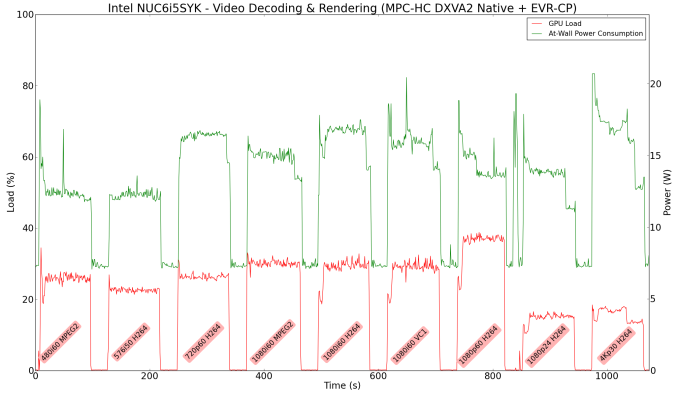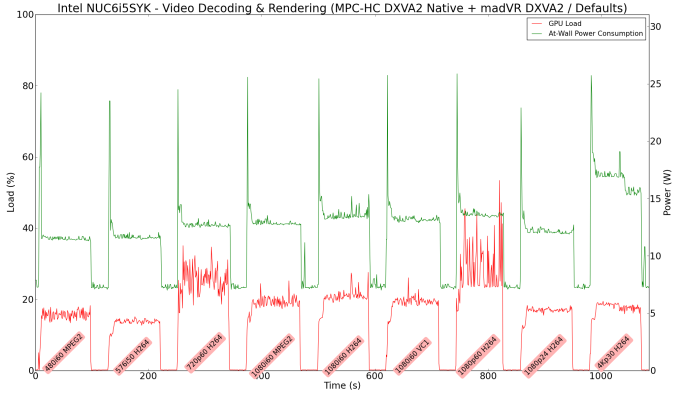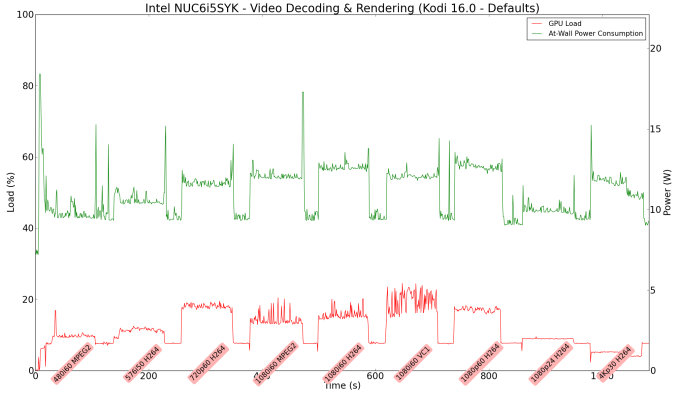The Intel NUC6i5SYK Skylake UCFF PC Review
by Ganesh T S on March 11, 2016 8:00 AM ESTHTPC Credentials
The thermal solution on the NUC6i5SYK is the same as what we have seen in the previous NUCs. Since the Core i5-6260U is a 15W TDP processor, the acoustics are pretty decent (when compared to the fans on the units with 28W TDP processors). Subjectively speaking, the unit is silent for most common HTPC use-cases. Only under heavy CPU / GPU loading (such as stressful madVR configurations) does the fan become audible. Like the previous NUCs, the NUC6i5SYK retains CIR support, enabling use of IR remotes in a home theater setting. The unit definitely makes a good HTPC for folks who don't want to pay the premium for a passively cooled system - however, we didn't find too many improvements over the previous NUCs for HTPC workloads. There is still no HDMI 2.0 / HDCP 2.2 / 4Kp60 HDMI support in the unit.
Refresh Rate Accuracy
Starting with Haswell, Intel, AMD and NVIDIA have been on par with respect to display refresh rate accuracy. The most important refresh rate for videophiles is obviously 23.976 Hz (the 23 Hz setting). As expected, the Intel NUC6i5SYK has no trouble with refreshing the display appropriately in this setting. In fact, the NUC6i5SYK has the most accurate display refresh rates of all the PCs that we have evaluated so far.
The gallery below presents some of the other refresh rates that we tested out. The first statistic in madVR's OSD indicates the display refresh rate.
Network Streaming Efficiency
Evaluation of OTT playback efficiency was done by playing back our standard YouTube test stream and five minutes from our standard Netflix test title. Using HTML5, the YouTube stream plays back a 1080p encoding. Since YouTube now defaults to HTML5 for video playback, we have stopped evaluating Adobe Flash acceleration. Note that only NVIDIA exposes GPU and VPU loads separately. Both Intel and AMD bundle the decoder load along with the GPU load. The following two graphs show the power consumption at the wall for playback of the HTML5 stream in Mozilla Firefox (v 44.0.2).

GPU load was around 24.27% for the YouTube HTML5 stream and barely measurable for the steady state 6 Mbps Netflix streaming case. Note that GPU usage reported by GPU-Z doesn't actually measure the load on the dedicated decoder engines in the GPU.
Netflix streaming evaluation was done using the Windows 10 Netflix app. Manual stream selection is available (Ctrl-Alt-Shift-S) and debug information / statistics can also be viewed (Ctrl-Alt-Shift-D). Statistics collected for the YouTube streaming experiment were also collected here.

Decoding and Rendering Benchmarks
In order to evaluate local file playback, we concentrate on EVR-CP, madVR and Kodi 16.0. We already know that EVR works quite well even with the Intel IGP for our test streams. Under madVR, we used the DXVA2 scaling logic wherever available, and left the rest at default (as it is well known that the stressful configurations don't work even on the Iris Pro-equipped processors). We used the DXVA2 native decoder in the LAV Filters bundled with MPC-HC v1.7.10
In our earlier reviews, we focused on presenting the GPU loading and power consumption at the wall in a table (with problematic streams in bold). Starting with the Broadwell NUC review, we decided to represent the GPU load and power consumption in a graph with dual Y-axes. Nine different test streams of 90 seconds each were played back with a gap of 30 seconds between each of them. The characteristics of each stream are annotated at the bottom of the graph. Note that the GPU usage is graphed in red and needs to be considered against the left axis, while the at-wall power consumption is graphed in green and needs to be considered against the right axis.
Frame drops are evident whenever the GPU load consistently stays above the 85 - 90% mark. The NUC6i5SYK has absolutely no trouble with any of our test streams. Kodi is the most power efficient of the lot, while madVR with DXVA scaling is actually quite power efficient and comparable to EVR-CP.
Moving on to the codec support, the Intel Iris Graphics 540 is a known quantity with respect to the scope of supported hardware accelerated codecs. DXVA Checker serves as a confirmation. Recent driver updates have added VP9 decode support, but, only for 8b encodes.





















95 Comments
View All Comments
twotwotwo - Sunday, March 13, 2016 - link
Coincidentally, I just got one of this model set up yesterday.In line with what the review says, it subjectively feels about as fast as the Broadwell i7 I use for work. I expected more difference just eyeballing the specs (though the i5's turbo clock is still 2.8GHz).
It's fun that you can now get a pretty decent computer, with perks like a PCIe SSD or lots of RAM, in a case no larger than some sandwiches I've eaten.
Setup wasn't fun. I had to use legacy boot to start Ubuntu off a Samsung NVMe drive, which was odd because BIOS could browse the EFI partition, Secure Boot was off, it could UEFI-boot off the SD card, etc. Lots of annoying trial and error to find the right config to get it booting, too.
In Ubuntu, I needed to use Intel's Linux graphics stack installer from 01.org to fix jerky video. Other than that hardware has worked out of the box.
soryuuha - Monday, March 14, 2016 - link
How does this box handle* H264 Hi10p
* HEVC
* HEVC Main 10
milkod2001 - Monday, March 14, 2016 - link
I still don't get why would anyone wanted to get NUC over laptop with screen,keyboard and OS already there.I can understand a few nerds who have time and knowledge to make the best of it but what about the average customers. Do NUCs actually sell well at all?
damianrobertjones - Monday, March 14, 2016 - link
Yes. They also look quite nice next to a large television in a front room.Also, for a company like the one here, buying Nucs seems like a reasonable choice.
Drazick - Monday, March 14, 2016 - link
Ganesh,Does Intel have any plans giving us GT3e in higher TDP configurations?
When I say higher I mean 90 Watt.
Even better to see it in the Extreme Edition (6829K + GT3e).
Shadowmaster625 - Tuesday, March 15, 2016 - link
$700 and it bricks when you update the BIOS? Where do I sign up?Brian_R170 - Tuesday, March 15, 2016 - link
"It all started with the first Intel NUC (Next Unit of Computing) based on a Sandy Bridge processor."Actually, the first NUCs were DC3217IYE (Ice Canyon) and DC3217BY (Box Canyon) and they both had an Ivy Bridge i3. The first (an only) NUC with a Sandy Bridge CPU was the DCCP847DYE (Deep Canyon) that came a few months later.
NextGen_Gamer - Tuesday, March 15, 2016 - link
I bought and configured one of these just a few weeks ago, and absolutely love it. I bought the NUCi5SYK, the same 16GB Corsair Vengeance DDR4-2400 kit as reviewed here, and a 512GB Samsung 950 Pro. It is amazing - I have had no glitches, freezes, or any issues so far. Of course, my unit started with the 33 BIOS as well. I built one of these for my office at work, and have two curved Samsung 23" 1080p monitors hooked up to it (one through the HDMI, one through a mDP-to-HDMI adapter). I would highly recommend it :)bogda - Wednesday, March 16, 2016 - link
NUC is not really intended for gaming or 3D rendering but if we test the GPU why do we get 3D Mark results instead of real game benchmarks?jacksonjacksona - Thursday, March 17, 2016 - link
( www).(ajkobeshoes).(com )christian louboutin
jordan shoes $60-
handbag
AF tank woman
puma slipper woman
=====
( www).(ajkobeshoes).(com )